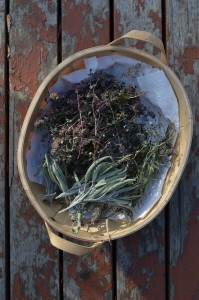Armed with this maxim many chefs spurn dried herbs. I’d like to go to bat for dried herbs. Not the dried herbs that have been in your pantry since Harper took office, and certainly not the dried powdered herbs you buy in one pound bags from a bulk store, but the dried herbs that you make from the plethora of fresh herbs you have languishing in your autumn backyard.
I take for granted that you have a plethora of fresh herbs languishing in your autumn backyard.
You should, because it’s important to use lots of herbs in cooking, and paying $4 for a 28 g packet at the grocery store is crazy. You can buy an entire plant for that amount, a plant that will grow to produce several times more herbs that are probably of a higher quality than what is available in stores. And if buying fresh herbs from the grocery store is crazy, buying dried herbs at their inflated cost is sheer raving lunacy.
What herbs to dry. Chefs distinguish between fine herbs and resinous herbs. Fine herbs are delicate and usually eaten raw. Examples are basil, parsley, chervil, and tarragon. Resinous herbs are more robust and are usually cooked. Examples are rosemary, thyme, oregano, marjoram, sage, savoury, and bay.
Fine herbs are terrible for drying. The flavour compounds in fresh fine herbs are extremely volatile, and the drying process drives them out with the water.
Most of our common resinous herbs, however, originate in the hot, dry Mediterranean, so their aromatics easily withstand the drying process.
How to dry herbs. Online you can find all sorts of tricks for drying herbs using an oven or a microwave.
Using an oven is a bad idea. Even at the lowest settings the heat will destroy the aromatics in the herbs. Microwaves happen to work brilliantly for drying herbs, because they selectively heat water, leaving the plant cells and the oily aromatic compounds more or less in tact. That being said, the truth is that you can make fantastic dried herbs without the help of any modern technology, because resinous herbs are already low in moisture, and they already have biochemical defences against micro-organisms, so they’re going to dry out fairly quickly as long as they are left exposed to air. Some techniques:
 Small quantities of herbs can simply be picked and left to dry in a basket or on a tray on the counter, as shown in the photo above.
Small quantities of herbs can simply be picked and left to dry in a basket or on a tray on the counter, as shown in the photo above.- Some herbs will dry naturally in the garden bed. They can be cut as entire dried bushes and brought to the kitchen.
- Potted herbs can be brought inside to dry out without being destroyed by frost.
- Large quantities of herbs can be bunched together with twine and hung from a hook on the kitchen ceiling, or from the rafters in your garage. If you plan to leave them hanging for a long while, it’s smart to hang them inside an inverted brown paper bag to keep dust off them.
Herbs with small leaves like thyme will dry in a matter of days. Larger specimens like sage might take a couple weeks to become completely dry and brittle.
How to Use Dried Herbs. As a rule resinous herbs, whether fresh or dried, should be cooked. Raw resinous herbs are chewy and bitter. Cooking removes some of that bitterness and draws the flavour of the herb into your dish.
While fresh herbs should always be added at the end of cooking, I usually add dried herbs at the beginning. For instance, if I’m making a soup or stew I’ll add the dried herbs while I sauté the onions and garlic. I don’t know if scientifically this is the best practice, but a part of me feels that the herbs need time to wake up and become sapid.
Dried herbs are very versatile and can be used with any type of meat, but to me their supreme companion is poultry. Beef has horseradish and mushrooms, pork has mustard, poultry has herbs.
Here’s a simple poultry rub to use up your plethora of dried herbs.
Poultry Rub
Ingredients
- 2 tbsp dried thyme
- 1 tbsp dried oregano
- 1 tbsp dried savoury
- 1/2 tbsp dried rosemary
- 1 tbsp sweet paprika
- 1 tbsp mustard powder
- 1/2 tbsp onion powder
- 1 tbsp ground black pepper
- 2 tbsp kosher salt
- 1/2 tbsp celery seed
Procedure
- Combine all ingredients in a bowl and mix thoroughly. Transfer to a glass jar with a tight lid and store in a dark pantry.
